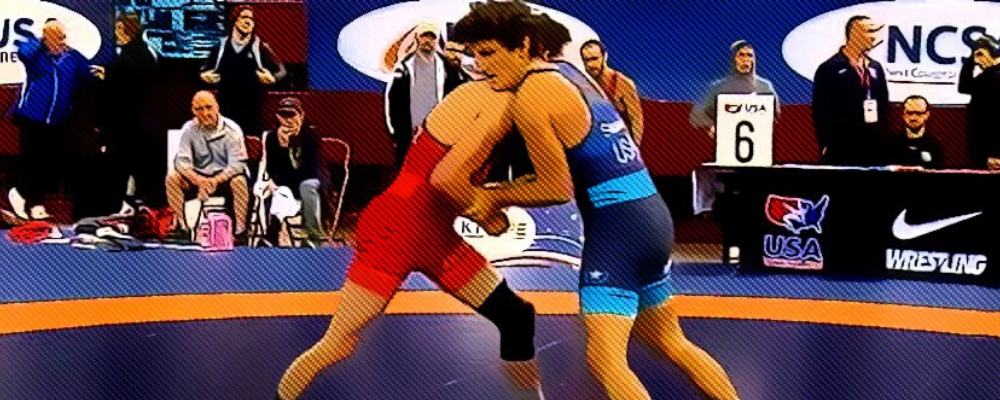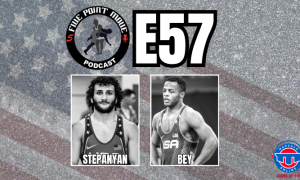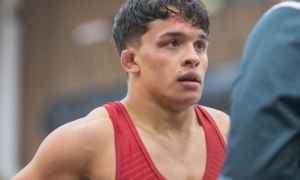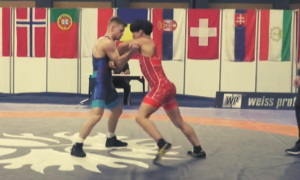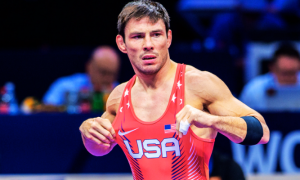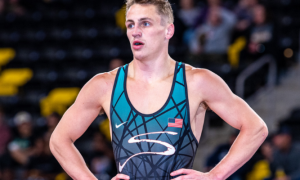Expectations do not often accompany young wrestlers onto campus at Northern Michigan University. The same can be said for American Greco competitors in general these days, wherever they train.
Think baseball. Superb high school and collegiate players who sign contracts with Major League organizations begin their professional careers for minor league affiliates. Then they disappear off the radar for a little while. Sometimes longer. But how quickly they progress is not nearly as important as the possibility that it could eventually happen. What occurs in the early stages — the struggles, doubts, disappointments — tends to unfold in the dark. Few outside of coaches and teammates bother to care. Front office staffs keep tabs on performance while taking a “wait and see” approach. ‘Just let us know when he’s ready’ is their directive and code-speak for ‘We’ll pay attention when he is actually competing for a spot.’
Entering this (now-prolonged) Olympic Year, no one expected David Stepanian (60 kg) to be “ready” for anything of significant consequence. Yet here we all are, sitting on an Olympic Trials postponement that will elasticize into 12 extra months, and a gawky teen who didn’t even make waves by committing to full-time Greco as a high schooler has some in the sport whispering the thought that he has a chance to don the country’s colors in Tokyo two summers from now.
It’s not that crazy.
In a room that includes the likes of National Team member Sammy Jones and 2018 World Teamer Dalton Roberts, Stepanian would seem to have a lot of ground to cover. Jones and Roberts are rightfully considered strong candidates for Tokyo, and so are about five or six others — if not more — from elsewhere around the nation. But before Stepanian was given the gift of additional time to prepare and prosper, he had already begun to demonstrate that, at the very least, he would present a threat to win the Last Chance Trials Qualifier — and perhaps pose even more problems at the Trials itself.
And that’s mainly because of two tournaments this past fall. First it was the Bill Farrell Memorial in November. A big one. The opening salvo. The Farrell acted as the season’s initial Trials qualifier, naturally stuffing the brackets and elevating the competition. Stepanian, who won the Austrian Open and had enjoyed a decent showing at the Junior Trials in ’19, was supposed to be a run-over in the minds of most. These were Seniors fighting for Trials spots. He shouldn’t have presented much of an issue for them. Right?
Except in his first bout, he clipped ’18 U23 World Team member Travis Rice (IRTC). The quarterfinal result was just as jolting. In that round, Stepanian laid waste to LilShawn Greedy (Army/WCAP) via tech. The 19-year-old didn’t win again in New York, ending the day with a 2-2 record. Regardless, when discussing the tournament afterward, the story coming out of 60 kilograms centered around Stepanian’s two huge wins and the manner in which they were recorded.
One month later at the Nationals, Stepanian found himself down 5-1 deep into the second period against ’18 Junior World Team member/’19 World Team Trials champ Brady Koontz (TMWC/Ohio RTC) when he corkscrewed a headlock to steal the victory. Following a loss to Ryan Mango (Army/WCAP) in the next round, it took a Herculean effort on the part of National Teamer Taylor LaMont to put Stepanian on the outside looking in.
That was over four months ago. It might as well have been a year.
The long strides Stepanian made heading into this season have only widened. He has some advantages, to be sure. His father, Arthur, competed for Armenia back when that country was under the thumb of the Soviet empire, and the late Aghasi Manukyan was highly-influential in Stepanian’s decision to peace out folkstyle. But locked away at home in Michigan, other items are now in play. Stepanian is observing a disciplined routine of workouts, and in between training on his own, he is formulating different means to challenge himself. That way, when competition returns, it’ll be a continuation.
No, better than that. Stepanian is convinced that he is onto something here. He could be right. Success as a Senior was supposed to be a little off into the distance but he feels like it’s within arm’s reach. He feels that the 60 kilogram spot on the US Olympic Team is his for the taking. The way Stepanian ends his sentences does the job of making you wonder about the possibility.
It’s not that crazy.
David Stepanian — 60 kg, NYAC/NTS
5PM: Austria put you on the map last season. That was a solid tournament for the US.
David Stepanian: That was a good tournament for me. The plus-two kilos really made the difference because I thought I could make 55 at that time, but I couldn’t not. But I made 57, that was not a good cut. It was a pretty hard cut. But once I got my fluids back in me, I felt way better. By the end, I versed a pretty good French kid (Yazid Gharbi). I think he took silver at the Cadet European Championships. I think I wrestled pretty well in that match towards the end.
5PM: One of the reasons the US goes to Austria is also the training situation. What did you get out of it last year as a high school senior training at NMU?
DS: One of the guys there was Austria’s Senior World Team member (Sargis Gevorgizyan), who also happens to be Armenian. I happen to speak fluent Armenian also, so I got to work with him most of the camp and it was really good learning from him. He was also at Thor Masters this year and the European Championships. It was good. It gave me confidence. I didn’t know where I was compared to other people yet, so I needed a little confidence boost to compare myself to others, and put myself in waters that weren’t tested yet.
5PM: I always ask young athletes that question. How do you compare yourself to others, especially because as an age-grouper in the US, you’re going to wrestle everyone, Juniors and Seniors. How do you use other athletes as a basis for comparison?
DS: Last year at Northern as a senior in high school, I would just try to learn from the other people in my weight class. Like, Randon (Miranda) was still there, Dalton Roberts, Sammy (Jones). I would try to see what was working for them and what they were doing to reach that success. I wasn’t trying to copy them, more like figure out what would work for me, too. Once I figured some things out, I would keep working on them after practice just thousands of times. I still do, the same way, to this day.
5PM: That’s the thing, Northern’s biggest strength is the lightweights. You have Sammy, who has been near the top for almost half a decade, Dalton was on the World Team. You have these really established guys you go against…
DS: And they all have different styles, so you take a little bit from everyone. I guess it’s like a dinner plate. Randon had really good counters, scrambling; Dalton is really good at keeping position and pressing forward; and Sammy has some really nice throws. You just try to take a little bit from everyone and make it your own craft.
5PM: How long did it to take you to be competitive against guys like Dalton and Sammy, and how much encouragement did you receive once you started hanging with them more?
David Stepanian: So last year, I was just getting beat up. One time I was wrestling Dalton in a 20 or 25-minute grind match. I don’t remember. It was something long. I remember I got the first takedown and I was so excited. And then for the rest of the 25 minutes, I don’t think I scored another point. I think I got beat probably like, 28 or 30-2. I just got killed.
But towards the beginning of this year, I felt like I could compete with other people. I’ve grown as an athlete. I’ve gotten stronger, filled out the frame, and I’m disciplined. It’s a combination of things that have helped me.
5PM: Andy (Bisek), aside from being an outstanding coach, also has incredible leadership qualities. But there are wrestlers in your room who are also great leaders. How does that affect the dynamic in the room as far as looking to other athletes as examples in terms of conduct?
DS: Last year, I still didn’t know what kind of direction I was going to take in Greco. I was still new, you know? But when you have people who lead by example, especially the more senior guys, that really helps let you know which direction you need to work towards to reach the goals that you have. We all have the same goal at Northern, to make World and Olympic Teams. Yeah, I may have come in for my high school year thinking it was easier. Not easier, but you have to see the hard work to put in to get perspective, and then work even harder.
5PM: Speaking of, what prompted you to decide to go to Northern for your senior year of high school? You kind of came out of nowhere. How did that process come about?
DS: Well, I’ve always liked Greco. My dad wrestled Greco in the Soviet Union, so I had always done the offseason stuff like Fargo. Nothing too serious. I was always a seasonal guy up till my junior year. I’d always go to Fargo. But my junior year of high school, around December, Aghasi (Manukyan) came to live with me in my basement for around two months. I actually practiced with Aghasi quite a bit after my folkstyle practices. He would show me technique and beat the crap out of me all the time. That was a big influence. Aghasi influenced me to to come to Northern. I had been to Big Brother camps before, too.
Also, in folkstyle, my whole junior year I didn’t really take a shot. I would just counter, throws, headlocks, inside trips. It was all upper-body. So I knew folkstyle wasn’t for me. I always liked throws. I was always interested in it, I just never dug too deep in it or had too much information at the time. Once Aghasi came, I got more information and became really interested. I was like, Oh, I want to do this my senior year. I decided to commit to it because I knew I didn’t want to wrestle D1 folkstyle, or any folkstyle at all. I did not enjoy it.
5PM: Have you ever looked back on your decision?
DS: No.

At the US Nationals in December, Stepanian (blue) needed to come up with a score late in the second period against Brady Koontz and a clutch headlock did the trick. (Image: FLOWrestling)
5PM: You were a candidate to compete at Junior last year, but you were still looked at a little young and green compared to others. But then you come out this fall in New York, and right off the bat, start beating Seniors. You grab a big win over Travis (Rice) and then another against LilShawn (Greedy). You talk about comparing yourself to others, well there you go. How did you feel after NYAC?
David Stepanian: Oh, I felt great. I was testing myself. I was training really hard prior to it, keeping my diet really clean to make 60 kilos. My mindset before was, I’m just going to go and send it. Whatever happens, happens. I don’t really care. I’m just going to leave it out on the mat 100%.
I was running on Sundays, staying after practice working on technique, working on the bands. Just doing little things to help with the mental edge. Just not being scared. That’s really it.
5PM: At the Nationals, you win your first two matches, beat Brady (Koontz). You might not have qualified for the Trials there, but it took a National Team member to take you out of the running in Taylor.
DS: That match hurt. It hurt a lot.
5PM: How did you see your focus after that? Was it based around having three months to prepare for the Olympic Trials qualifier? Or were you looking at it like, I’m going to put all my effort towards the Olympic Trials, and worst case, I’ll have the Junior Trials?
DS: I was looking at it like I know I can compete with the top guys. I was just missing a little bit from that. That’s the stuff that motivates to stay after and fix a little bit of my technique or do a couple of extra reps, push-ups, or work on something. It just keeps adding fuel to the fire. Motivation. The losses don’t really put me down, I guess you could say. Maybe right after the match it is, Damn, I just lost. But afterwards, it is, I was close.
5PM: You’ve said that before, “stay after”. Is that a big part of your deal, extra work to cover ground?
DS: It’s not necessarily that, but I feel better if I know I’m doing more work than other people. It just makes me feel better. I don’t know how else to really explain it.
5PM: Describe what you’re doing now in the absence of the Superior Dome and practice partners.
David Stepanian: Luckily, I have a 10’X10′ mat in my basement with a 55 lbs dummy. I’ve been training with this dummy, doing workouts. I have a pull-up bar here, too. It is just the complete setup so I haven’t stopped. I’m obviously not practicing with the same volume like at Northern, but I’m keeping fresh and in-shape and running. I’m not going to let the quarantine get me fat and out of shape. I’ve also been practicing with my dad. He’s a great Greco mind with very good technique.
Follow David Stepanian on Twitter and Instagram to keep up with his career and competitive schedule.
Listen to “5PM37: The wildman Sammy Jones” on Spreaker.
SUBSCRIBE TO THE FIVE POINT MOVE PODCAST
iTunes | Stitcher | Spreaker | Google Play Music


